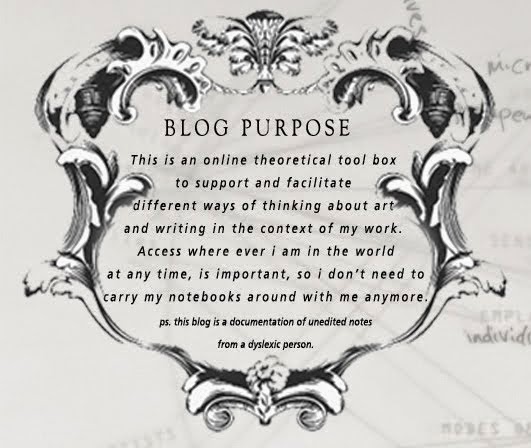from Gibbons.G. Art and advertising. (2005)
chapters in file:
independent reading 1.1 folder
JOAN GIBBONS. Art and advertising.
‘The idea is not to replace the adverts text with another
hierarchy, but critique rather than substitute”. Process
of recovery p11 Remote control Barbara Kruger.
Is the Advertising agent
subverting the truth, not the artist? Does the work bring art closer to
adverting? By using branding and packaging, does it make art more socially
relevant?
Packaging as site-specific? Sins of capitalism. Active engagement in
popular forms of representation.
Transitory cultural interventions. Other form of street art- change the
way that social space is produced and consumed.
Activist art is a form of cultural terrorism where a vital message is
conveyed quickly. Outdoor sites . Aura of the work (in my case the fictitious
brand, the developed signature style, distinct type of imagery that is
recognisable to the equivalent brand that is being critiqued).
Word based art.
Conceptual wordsmith (Lawrence
weiner).
‘The practice of parody’ making
a joke out of something and process of assimilation.
Agitataional propaganda (agit
prop, displayed in readily accessible of mass communication and popular
culture, sometimes refered to as ‘non-places’the streets to spead the
revolutionary message widely, quickly, and as directly as possible artist –
burgin, leeson, dunn, Levine, kruger and Holzer), laboratory art (visual
research of a formulist nature that underpins production art), production art.
Chapter 2
Looks at how artists have
invaded the advertising space and marketing system of the art world by appropriation
of the advertising language as well as forms, and spaces of advertising. Ie the street, billboards, poster art,
packaging, promotional imagery, making art more publically accessible. There is
a desire to take art closer to the public, bring art closer to life and raise
political awareness, this was also one to deliver oppositional messages in an
accessible way, criticism of values.
Artists use of the billboard
contributed to moving out of the gallery space and raise social and political
awareness of direct expression. It is seen as activist work.
In the 1980’s, artists
critiqued the media yet also benefited from it in the same way.
….artists had to negotiate
the space between high art and mass culture, between the elite audience and the
general public, between rejection of the system and acceptance of it’….
P30 quote by Richard Bolton.
Vance Pacard
(1914) an American social critique, journalist and author of ‘the hidden
persuaders’ questions the role of adverting, the morality of the psychological
persuasion techniques used in the advertising industry to increase sales.
Victor Burgin
(1941) He studied painting at the Royal
College of Art from 1962 to 1965 and philosophy and fine art at Yale University
from 1965 to 1967. examine the relationship
between apparent and implicit meaning, his series uk76 turned the strategies of
consumer advertising against themselves and exploited the contradictions of
capitalism. artist and writer. Imagery ‘ what does possession mean to
you? He redefines the language of art by
appropriating the form of advertising.
Restructuring the visual and verbal language. Expose contradictions in
our class society. To reveal the underlying structures that are going on rather
than obscure the underlying structure and get across a product name.
Artist Les Levine: is concerned with exposing relationships between art and commerce
(disposables 1966, Levines restaurant 1969). He also seeked to expose the
business and marketing systems upon which the art world is founded. Torture god, and blame god billboard posters
were funded by ‘art angel’. His work
sits between art and advertising that deliberately disrupts and outrages the
public. And provocative on a political level.
This sort of work encourages
the viewer to rethink conventional advertising and branding.
Barbara Kruger:
deals with economy of images and text which beckoned and fixed the spectator,
she admitted that her method combined the ingratiation of the wish desire of
advertising with her own’ criticality of knowing better’. Here Kruger
acknowledges that she shared common strategies with advertising. She states in an interview for eye magazine
that she sees herself as someone who works with pictures and words, not as a
graphic designer she once was, where her work stems from. Her method combines
the imitation of the ‘wish desire’ of advertising with her own ‘ criticality of
knowing better’. She acknowledges shared common strategies with advertising and
used this device to get people to look at the picture and then to displace the
conventional meaning that the image usually carries with perhaps a number of
different meanings. Kruger provokes
reflection upon the ideological role of language.
PARODYING ITS FORM – to
distort, imitate, humorously satirical, ridicule something serious.
Walter Benjamin The author as
producer

